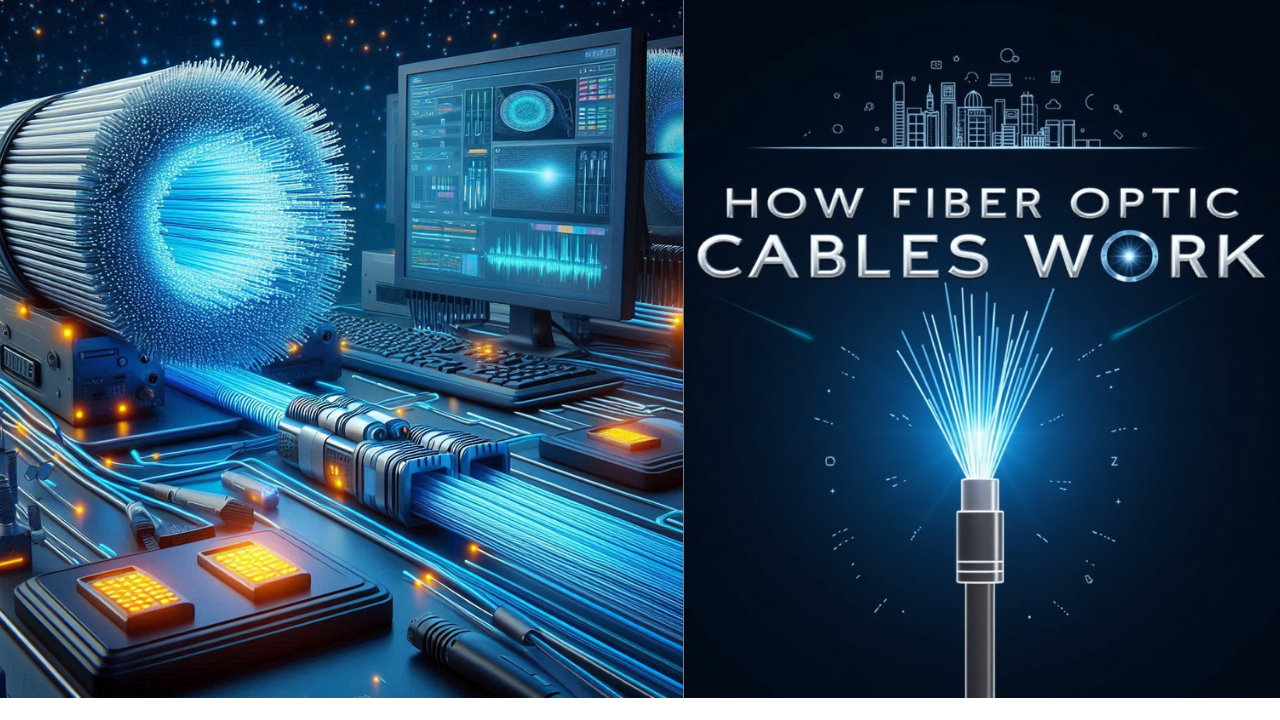In today’s digital era, fiber optic cables are the backbone of high-speed internet, telecommunications, and various other applications. Understanding how these cables work can help us appreciate their impact on modern communication. In this blog post, we’ll delve into the details of fiber optic cables, explaining their components, working principles, types, advantages, applications, and challenges. This SEO-optimized guide aims to provide valuable insights for both tech enthusiasts and the general audience.
Basic Concepts
Fiber optic cables operate on the principles of light transmission and total internal reflection. Light signals travel through the core of the fiber optic cable, bouncing off the walls in a series of reflections. This allows the light to travel long distances with minimal loss. The core and the cladding have different refractive indices, ensuring the light remains within the core by reflecting back when it hits the cladding. Understanding these basic concepts is crucial for grasping how fiber optic cables work.
Components of Fiber Optic Cable
A typical fiber optic cable consists of three main components:
- Core: The thin glass or plastic center where light travels. It is designed for efficient light transmission.
- Cladding: A layer of material surrounding the core with a lower refractive index, which helps reflect light back into the core, preventing signal loss.
- Buffer Coating: The outer protective layer that shields the core and cladding from physical damage and moisture, ensuring durability and longevity.
Types of Fiber Optic Cables
Fiber optic cables can be broadly classified into two types:
- Single-Mode Fibers: These fibers have a small core diameter, typically around 8-10 micrometers, allowing only one mode of light to propagate. They are ideal for long-distance communication, reducing dispersion and signal loss.
- Multi-Mode Fibers: These fibers have a larger core diameter, usually around 50-62.5 micrometers, allowing multiple modes of light to propagate. They are suitable for shorter distances, such as within buildings or on a campus, where high bandwidth is required.
How Fiber Optic Cables Work
The process of transmitting data through fiber optic cables begins with a light source, such as an LED or laser, generating the light signal. The light signal is then transmitted through the core of the fiber optic cable. As the light travels, it bounces off the walls of the core through total internal reflection. The cladding ensures the light remains confined within the core, preventing it from escaping. This process allows the light signal to travel long distances with minimal loss and high speed, making fiber optic cables highly efficient for data transmission.
Advantages of Fiber Optic Cables
Fiber optic cables offer several advantages over traditional copper cables:
- High Bandwidth: Capable of transmitting large amounts of data at high speeds, making them ideal for high-speed internet and telecommunications.
- Long-Distance Transmission: Unlike copper cables, fiber optic cables can transmit signals over long distances without significant signal loss.
- Low Interference: Immune to electromagnetic interference, ensuring clear and reliable signals even in environments with high levels of electrical noise.
- Security: Difficult to tap into without disrupting the signal, making them more secure for transmitting sensitive data.
Applications
Fiber optic cables are used in a wide range of applications, including:
- Telecommunications: The backbone of modern telecommunications networks, enabling high-speed internet, telephone, and television services.
- Internet: Core infrastructure of the internet, providing high-speed data connections for homes, businesses, and data centers.
- Medical Equipment: Used in advanced medical diagnostic tools, such as endoscopes, to provide clear and precise imaging.
- Military and Aerospace: Employed in military and aerospace applications for secure and reliable communication.
Challenges and Limitations
Despite their advantages, fiber optic cables face several challenges and limitations:
- Installation Complexity: Requires specialized skills and equipment, making the installation process complex and time-consuming.
- Cost: Higher initial investment compared to traditional copper cables. However, the long-term benefits and lower maintenance costs can offset the initial expense.
- Vulnerability to Damage: Easily damaged by physical forces, such as bending or crushing. Proper handling and installation are crucial to ensure their reliability.
Conclusion
Fiber optic cables have revolutionized the way we communicate, offering unparalleled speed, reliability, and security. By understanding how these cables work and their numerous applications, we can appreciate the technology that powers our modern world. As advancements continue, fiber optic technology will likely play an even more significant role in enhancing global connectivity and communication.
